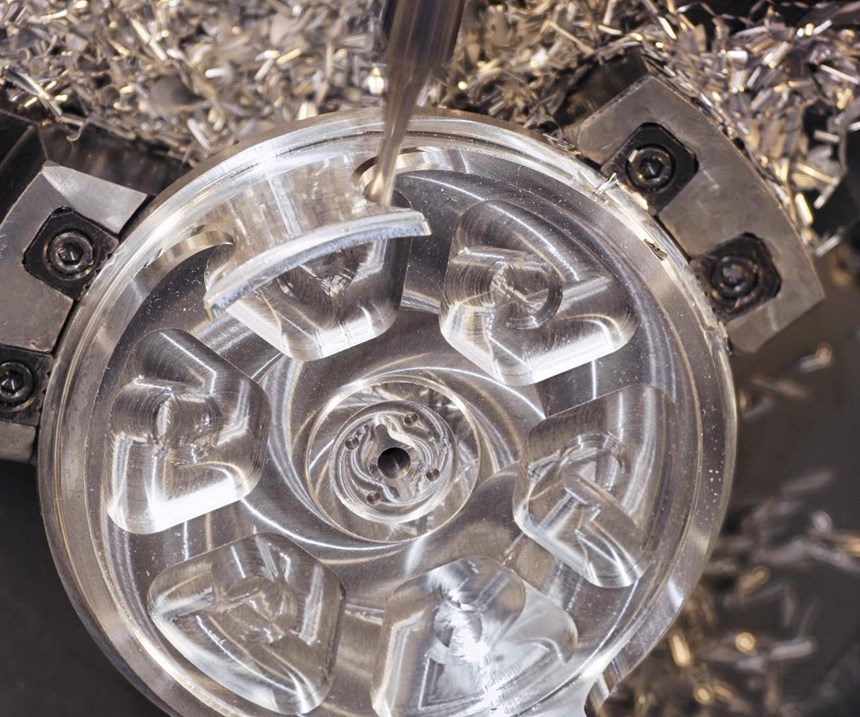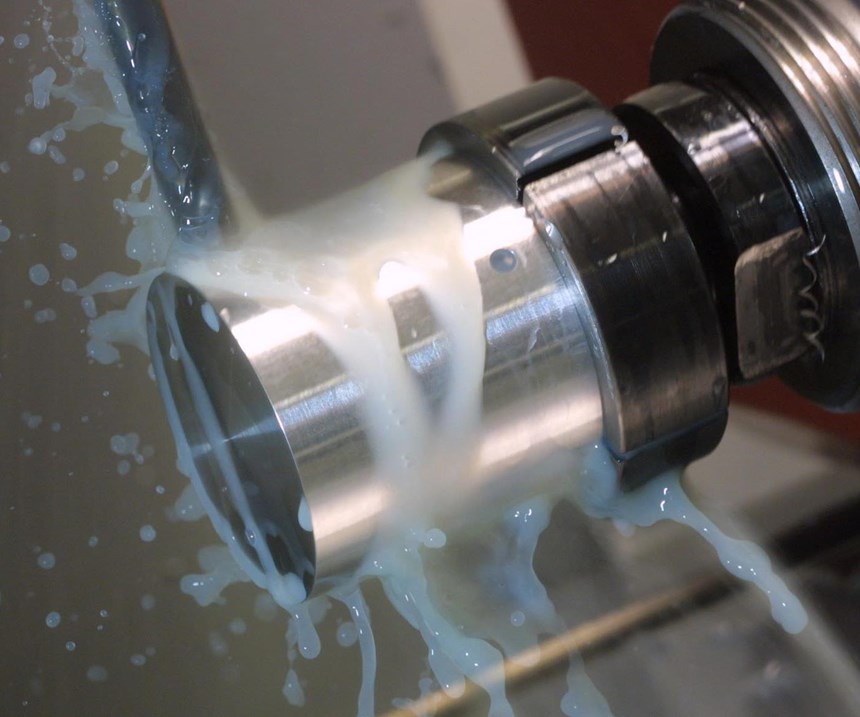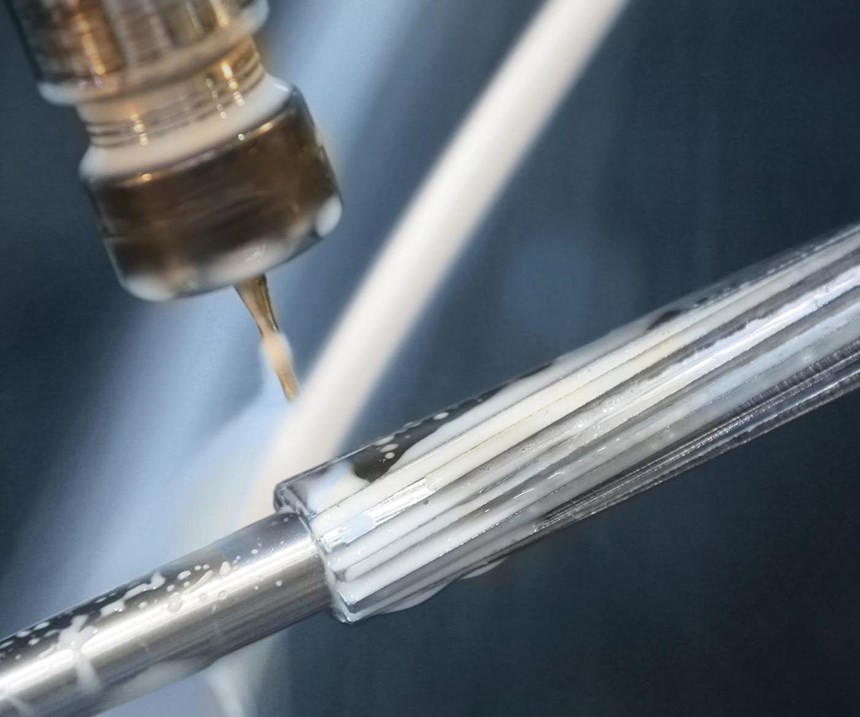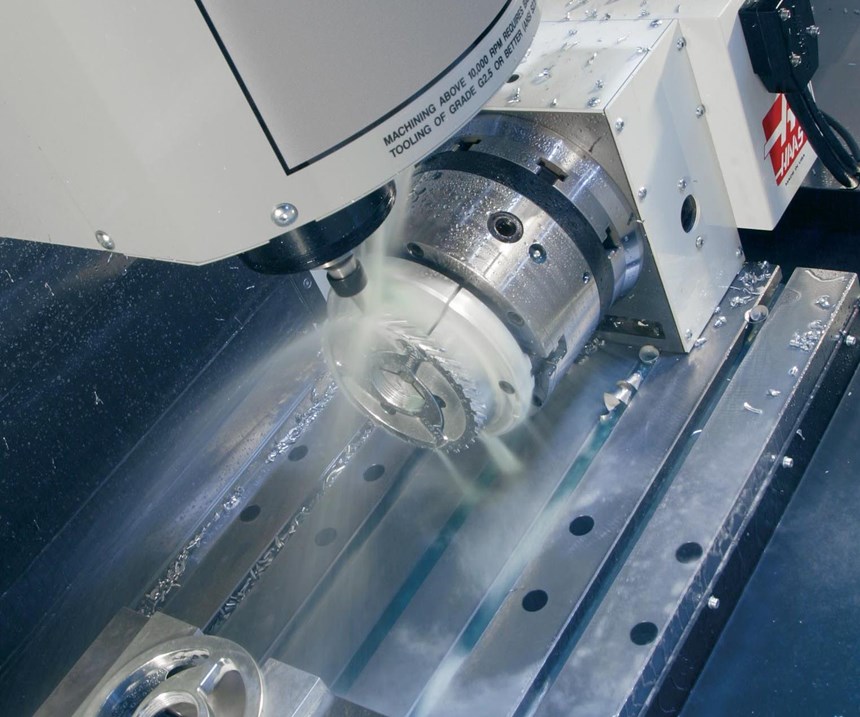Selecting A VMC: Factors To Consider
A three-, four- or five-axis vertical machining center can run the gamut of capability and cost. Assessing your application requirements now and in the future can make for a much wiser machining center purchase.
Current economic conditions persuade many precision-turning shop owners to reassess their operation. With an eye to cutting costs, they are looking for greater capability to bring some primary or secondary operations in-house. Frequently, a CNC vertical machining center (VMC) is the best solution, especially when teamed with the right CNC rotary product. But there are many machines and options—and manufacturers—out there, so selecting the right VMC and rotary for your shop can get tricky!
If your shop is like most, the perfect VMC lies somewhere between a compact 3-axis machine that can be rolled through a standard office door and a big 5-axis job the size of a semi-trailer. And VMC prices have a similar range. But the pain of investing in a high-tech chipmaker does not have to equate to getting a root canal. With a little patience, rational thinking and steady nerves, you can select the right one for your shop—and your wallet!
Feed Your Need
Logically, the first thing to do when buying anything is to consider what you really need. Ask yourself what the VMC will be required to do—include production goals, types of operations and materials you’ll be cutting. The VMC should have adequate spindle speed, rapids, axis travels and table size for your process. And it’s always a good idea to keep future plans in mind.
Accuracy is a great example. The latest high-tech, high-precision machines can hold extremely tight tolerances—but extreme precision often comes at extreme expense. Some shop owners, especially first-time CNC buyers, needlessly over-spec their machines, spending too much money for precision capability far greater than their jobs will ever require. Others “buy cheap,” only to find their machine quickly loses accuracy and repeatability. Both examples cut into profits, which is the real purpose of any investment. Do your homework, and avoid unnecessary expense!
Do you need a rotary device? The basic VMC is a 3-axis machine in which the part is fixed to the table, allowing 3-dimensional cutting on one side. Adding a 4th- or 5th-axis rotary to the VMC allows the part to be rotated for machining on a different side or angle, without requiring a new setup—a common requirement for turned parts. We’ll cover more on rotary devices later.
The Likely Prospect
Once you have a handle on your needs, and your hours of Internet surfing and calls to associates seem to indicate a machine that passes muster, your job is done, right? Wrong! The manufacturer of the machine is just as important as the specs. Do they have a reputation for quality machines and fast service? Do they offer a complete line of products, including VMCs, HMCs, CNC lathes and rotary products? Do they support previous models? If the company doesn’t support their older models, the chances are good they won’t support your model in the future.
Look for a machine tool builder with a distributor network that provides local sales, applications and service support, with fully stocked service vans, and efficient, factory-trained technicians. They should offer installation and training, and provide upfront, fair pricing and financing. And most dealers can arrange a cutting demo—ask to bring a sample of the same material you will be machining in your shop.
Quality Time
Over the years, machine tools have evolved into amazing high-tech wonders. Just a few years ago, linear guides were new, and box ways were the standard. Now, nearly every reputable machine tool builder uses linear guides. Improvements in the control and axis servomotors and many other enhancements make everyone’s life easier.
But, while some things have changed, some have not. Cast iron is still considered the most vibration-damping material for machine-tool castings, and most quality machine tools use this material. Look into the machine base, if you can, to see the cast-in ribs designed to strengthen the base and help damp vibration for higher accuracy and better surface finishes.
Check out the quality of the whole machine—how well the parts fit together and the overall care in manufacturing. Visit other shops that use the brand and model of machine you’re looking at. Ask how it performs, and about its uptime, strengths and weaknesses. A long, trouble-free working life means a lot less expense in the long run.
Easy Does It
Consider well the control; it’s how the programmer and operator communicate with the machine. Is it easy to understand and use? Is it intuitive, or does it require extensive training to learn? Is the control designed and serviced by the machine tool builder, or by a third-party? The functionality and features of the control largely determine the functionality and ease-of-use of the machine, so it deserves serious consideration.
Talk to shop owners and operators who use the machine you’re considering. Some controls provide only limited help, while others provide on-screen, menu-style help screens and intuitive programming. Some allow importing .dxf files directly into the control, and programming without knowledge of G-code. Most controls have alarms for almost every fault imaginable, but some controls explain those faults much better than others. Background editing is another nice feature, as well as the ability to override speeds and feeds while the program is running.
Other control features/options to consider are expanded program memory, high-speed machining software, Ethernet and USB connectivity, coordinate rotation, scaling and user-definable macros.
If you plan to add more machines in the future—say, a lathe or horizontal machining center—check to see if the control is the same for all the machine types. This could prevent having to learn a new control.
Consider the Options
VMCs are available with a wide variety of options that make your life easier and your machine more productive. Again, ask yourself, “What do I need?” Having options factory-installed when you buy the machine is usually the least expensive way to add features and capabilities, although many options can be installed in the field.
Some of the most popular options are:
· 10,000-, 15,000- or 30,000-rpm spindles
· 50-taper spindles and more torque
· Faster rapids
· Automatic chip-auger or belt-type chip conveyor
· Side-mount tool changers
· Through-spindle coolant or programmable coolant nozzle
· Remote jog handle
· Linear scales
· 4th- and 5th-axis capabilities
· High-speed machining control software with full look-ahead
· Ethernet connectivity
· USB connectivity
· Rigid tapping
· Work and tool probe systems
· Much more
So what options are right for you? First, identify the options available for your prospective machine. Make sure you understand exactly what each option does, and then decide what you need or may need ongoing.
Rotary Tables and Indexers
One of the most efficient ways to add flexibility and capacity to a VMC is with a 4th- or 5th-axis rotary device.
As mentioned earlier, a VMC is a vertical-spindle machine that cuts in three axes, with the part mounted to the table. Often, the next operation requires the part to be rotated to expose another side to the cutting tool. The part must be removed from its fixture, turned to the next side and then installed in another setup . . . unless you have a rotary product to automate the process.
CNC rotary tables usually mount to the VMC’s table via standard T-slots, and typically are placed on one end, with the table’s platter perpendicular to the X axis. The rotary unit provides circular motion along the A-axis, which moves the workpiece into position. Depending on the host machine and the method of control, rotary tables can provide full 4th-axis simultaneous motion, semi 4th-axis motion or simple indexing.
With simultaneous 4th-axis machining, the host machine has a built-in 4th-axis drive, and the rotary device is programmed and controlled directly from the machine's control. The workpiece is rotated as it is machined, and the rotary table’s A-axis interpolates fully with the X, Y and Z axes.
With semi 4th-axis operation, the rotary device is programmed and driven by a stand-alone servo control that, in turn, is connected to the host machine. Signals from the host machine trigger the servo control to index the rotary table to its next programmed position. The workpiece is rotated as it is being machined, but the programmable control does not interpolate the A-axis with X, Y and Z moves of the CNC machining center. However, spiral milling and helical cuts can still be achieved utilizing special codes and calculations, with an M-code to trigger a simultaneous move. Simple indexing is possible with a rotary control box and a quill switch or MFIN cable.
4th-Axis Rotary Tables
The single most important capability of the rotary table is the ability to automatically position the workpiece so that two or more sides of a part can be machined with only one setup. For example, all the exposed sides of a valve body can be machined with one setup on a rotary table. Typically, this reduces machine idle time and increases accuracy. When two or more valve bodies are mounted on a rotary table, setup time, cycle time and the number of tool changes are reduced, plus accuracy is increased. In another example, parts with angled cross holes can be machined with one setup on a rotary table, in contrast to two setups with a vice and special angle fixture block. Other fixtures and tooling, such as tombstones, allow multiple sides of multiple parts to be machined with fewer setups and tool changes.
Most rotary tables have T-slots arranged radially on the platter face, and a precision pilot hole or through-bore in the center to simplify fixturing. Some shops mount chucks to the platter (or spindle nose) to further increase utility. For long parts, a rotary table may be paired with a tailstock or A-frame support mounted to the VMC table for stability and strength.
4th-Axis Indexers
The relatively small, programmable 5C collet indexer is a very popular rotary design. This type holds parts by means of a manual or air-actuated collet. Round parts, or parts mounted to a shaft, insert quickly and easily into the collet for rapid changeout for the next cycle. If you consider one of these, read the specs carefully. The term “indexer,” however, is a misnomer, as these units provide continuous rotation, and can position to virtually any angle (check the resolution spec). Collet indexers lend themselves well to production of multiple small parts per setup, with some manufacturers offering multiple-spindle designs and special tooling.
5-Axis Machining
Adding a 5th axis of motion (tilting the 4th axis) can provide even more versatility, and allow machining of very complex parts and geometries in a single setup. This gives shops the ability to do jobs that others turn away, or do in-house jobs with fewer operations and setups. Machining in 5-axes can produce astonishingly intricate detail and compound curves—design features common in today’s complex devices.
There are two primary types of 5-axis rotary tables, tilting tables and trunnion tables. Tilting tables typically consist of one rotary unit mounted to the platter of another to provide two axes of motion, usually 360 degrees of rotation and ±120 degrees of tilt. Trunnion tables typically have a rotary platter built into a casting that is supported by a rotary device on each end. The two supporting rotary devices provide the tilt, and the built-in platter provides 360 degrees of rotation. Trunnion tables provide additional support for heavy machining, and usually require less Z-axis clearance. Both types provide precise positioning in the 4th and 5th axes, and hold the part securely during machining.
As with single-axis rotary tables, dual-axis units can provide full simultaneous 4th- and 5th-axis motion, semi 4th- and 5th-axis motion or simple 5-axis positioning, depending on the host machine and method of control. If you are considering a rotary device from a manufacturer other than the builder of the VMC, be sure to check the device’s compatibility with the VMC.
The Rest of the Story
Investigate VMCs and rotaries carefully. Ask yourself what you need, and then consider the specs and details of the prospective machines. Ask associates about their experiences with their own machines, and check out the manufacturer’s reputation. Quality and service should be high priorities to ensure maximum uptime. Above all, have a realistic budget. Ponder options and rotary products carefully —with an eye to the future.
Keep in mind that you may not find one machine that does everything you want at a price that fits your budget, but identifying the strengths and weaknesses of any potential purchase will help you make wise compromises.
These are some of the major points to mull over when you start your search for your VMC and/or rotary. Keep a cool head, be thorough—and increase your profits!
Related Content
Understanding Micro-Milling Machine Technology
Micro-milling can be a companion process to turning-based production machining. This article looks at some of the technologies that go into a micro-milling machine and why they are important to successful operation.
Read MoreFive-Axis Machining Center Performs Cutting Operations in a Single Setup
PMTS 2023: Haas’ UMC-350HD is a compact five-axis universal machining center Capable of performing 3+2 and five-axis machining simultaneously.
Read More5-Axis Machining Center for Milling Diverse Materials
PMTS 2023: The Grob 6350 Generation 2 Universal Machining Center has the ability to rough and finish on the same machine to produce a complete part in one setup for increased productivity.
Read More5-Axis Machining Centers Transform Medical Swiss Shop
Traditionally a Swiss machine shop, Swiss Precision Machining Inc. discovers a five-axis machining center that has led the company to substantial growth. (Includes video.)
Read MoreRead Next
A Tooling Workshop Worth a Visit
Marubeni Citizen-Cincom’s tooling and accessory workshop offers a chance to learn more about ancillary devices that can boost machining efficiency and capability.
Read MoreDo You Have Single Points of Failure?
Plans need to be in place before a catastrophic event occurs.
Read More5 Aspects of PMTS I Appreciate
The three-day edition of the 2025 Precision Machining Technology Show kicks off at the start of April. I’ll be there, and here are some reasons why.
Read More


























